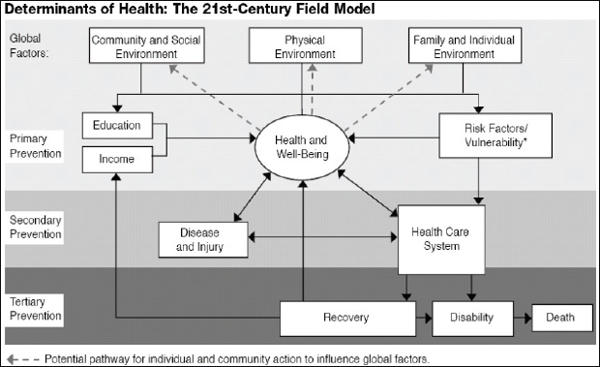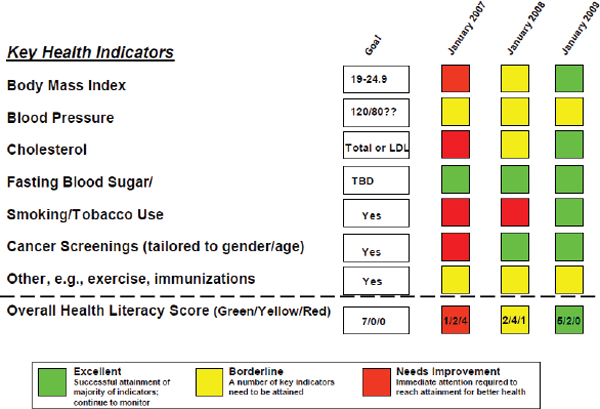3
Commissioned Paper on Integrating Health Literacy into Primary and Secondary Prevention Strategies
Scott C. Ratzan, M.D., M.P.A.
Vice President, Global Health
Johnson & Johnson
In this presentation, Ratzan offered a brief overview of the ideas presented in his paper, Integrating Health Literacy into Primary and Secondary Prevention Strategies (see Appendix C). Health literacy is evolving, he said, from the well-accepted definition of “the degree to which individuals have the capacity to obtain, process and understand basic health information and services needed to make appropriate health decisions” (Ratzan and Parker, 2000) to a conceptual framework of activities worldwide. The United Nations Ministerial Declaration (United Nations, 2009) stressed that “health literacy is an important factor in ensuring significant health outcomes” and “call(ed) for the development of appropriate action plans to promote health literacy” separate from domestic initiatives.
To understand health literacy’s role in prevention, Ratzan revisited Winslow’s definition of public health. According to that definition, “Public health is the science and art of preventing disease, prolonging life and promoting physical health and efficacy … which will ensure every individual in the community a standard of living adequate for the maintenance of health” (Winslow, 1920). Similarly, the Institute of Medicine describes public health as “fulfilling society’s interest in assuring conditions in which people can be healthy” (IOM, 1988). Public health is not defined solely by health care, Ratzan said, but rather is shaped by what people do each day outside that system. He emphasized this point by offering a conceptual framework known as the Field Model (Figure 3-1), which was originally introduced by Evans and Stoddart in “Producing Health, Consuming Health Care” (1994).

FIGURE 3-1 Determinants of health: The 21st century field model.
SOURCE: Ratzan et al., 2000.
Health and well-being are not primarily determined by the health care system; but the health care system is where most of the costs are. Public health professionals work to keep people out of the system by stressing the importance of primary and secondary prevention. In global health, there is an emphasis on the social and environmental determinants of health. One example is the focus on maternal education, which has led to greater improvements in health and well-being worldwide than anything else, Ratzan said. Cancer, heart disease, and type-2 diabetes are costly to treat, but they can be prevented through relatively inexpensive and cost-effective interventions, including effective communication. Health literacy is at the nexus of creating better communication and education so as to increase the effectiveness of both primary and secondary prevention efforts. Primary prevention refers to actions designed to avoid illness and stay healthy. Secondary prevention refers to interventions aimed at recovery from an illness or injury or managing an ongoing, chronic condition or disability that affects function. People need simple instructions about what they need to do to stay healthy and avoid disease. They need ways to measure or score themselves on how well they are doing, Ratzan said. Furthermore, those who are already living with an illness need information on managing their condition or disability that affects everyday life.
To measure effectiveness of preventive care, Ratzan proposed using a health literacy scorecard which would contain a limited number of
key health indicators that are associated with a healthy physical and mental state. Figure 3-2 provides some examples of potential indicators. Individuals would rate their scores against a standard that could have predictive value for age and disease probability. The challenge would be to ensure that the variables selected measure things that are amenable to health literacy interventions.
The goal of the scorecard would be to introduce people to preventive measures and help them understand associated goals. Some scorecards could be self-reported. There could also be scorecards that are state-administered such as those related to lead screenings or immunizations. In order for the scorecard to be effective, Ratzan said, the scorecard needs to be simple and people need to be provided with incentives to improve their health, such as lower premiums for health insurance.
One example of a scorecard currently in use in Minnesota is the D5 scorecard for secondary prevention of diabetes. It evaluates health based on five goals for living well with diabetes: controlling blood pressure, lowering bad cholesterol, maintaining blood sugar, being tobacco-free and taking aspirin daily. The D5 website (www.thed5.org) provides information that shows how well clinics are doing in helping their patients achieve D5.

FIGURE 3-2 Health literacy scorecard.
SOURCE: Ratzan, 2009.
Creating a health literate public will be a multi-faceted effort. Ratzan suggested three domains in which efforts can be mounted to improve health literacy: the health system, the educational system, and media and new technology. The health care system can help develop individual and population health literacy by creating health information that is easily understood, by training providers to work with populations of low health literacy, and by making the system more easily navigable. The educational system can contribute to a health literate public by increasing patient skills through all levels of the education system and it can work with people with limited literacy, help equip families and communities with self care strategies, and prepare a health literate workforce.
Finally, media and new technology are useful tools for reaching people with credible and understandable messages. For example, pregnant women could volunteer to receive SMS (Short Message Service) messages reminding them of certain stages in their prenatal care. Cell phone messages may be a way to reach populations without access to the Web.
Ratzan concluded his presentation with several recommendations for improving health literacy. These recommendations are presented below:
- Develop and fund a health literacy scorecard focused on basic prevention, wellness awareness and behaviors, and a system that supports attainment of the prevention activities.
- Health systems must simplify the demands and complexities of those engaged in prevention activities. The Centers for Medicare and Medicaid Services could play a lead role in this simplification. Incentives could be created for health literate communication with seniors. Pediatric health literacy (measures and goals) could be integrated into the State Children’s Health Insurance Program materials.
- Define what it is that individuals must do to access necessary health services. Federal agencies responsible for addressing health disparities should support the development of new quality standards that reduce the demands and complexity of the health system.
- The National Institutes of Health should develop, test and implement health communication approaches.
- Health literacy measures are needed at the state and local level. The National Governors’ Association, mayors, civic organizations and other organizations should address and adopt health literacy measures of their constituents that integrate primary and secondary prevention into sustainability and other social sector goals. Private-public partnerships could be fostered to create demonstrations and incentives which could be modeled after the World Health organization Healthy Cities Consortium.
- The Department of Health and Human Services should develop, test, and implement culturally appropriate measures of health literacy.
- The Department of Education should develop a health literacy competency base for elementary and secondary education.
- The Department of Labor should adopt a healthy workplace policy that includes health literacy goals.
- Accrediting bodies for health professions should incorporate health literacy into their accreditation processes.
- Comparative effectiveness, including those in development by the Agency for Healthcare Research and Quality, should integrate health literacy into the interventions under consideration, particularly in the areas of behavior change and prevention.
There is a great deal of work to be accomplished, Ratzan said. Two major challenges are to give individuals the basic skills necessary to navigate a complex health system and to work with the health system to make it more navigable. Addressing these challenges will require multiple stakeholders taking multiple actions, including those in the recommendations just mentioned, Ratzan concluded.






